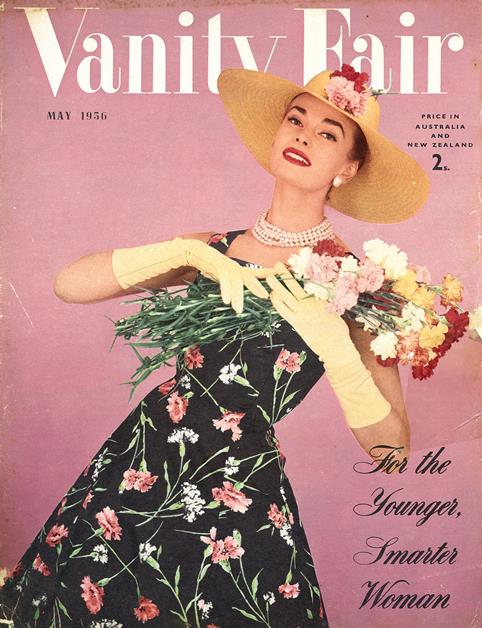If there was one kind of garment that was particularly conservative in the 1950s, it was the summer dress. Dresses with bouffant skirts and nipped in waists remained popular throughout the decade. This is not to say that there were were no changes at all; just that the changes were incremental and mainly consisted of tweaking details. A hemline raised or dropped, the shape of a collar, the width of a belt or sleeve could make all the difference...
 |
| Wakes catalogue, Spring and Summer 1950 |
Here we have a couple of dresses definitely designed for adults! The skirts are long and full, falling to the bottom of the calf. They are made up in (the ever popular) floral prints. However the flowers on these dresses are bigger and splashier than the patterns popular in the 1930s and 1940s. Later in the decade we'll see a range of "modernist" abstract prints appear along with the traditional floral designs.
 |
| Vogue Pattern Book, June-July 1951 |
Vogue Pattern Book featured this "romantic sheer dress, wide of neckline, sleeves, skirt" on the cover of its June-July 1951 issue. The pattern is a check this time, and it's accessorised (of course!) with wrist length white gloves.
 |
| Australian Home Journal, December 1952 |
The Australian Home Journal pairs another "romantic sheer" (with sweetheart neckline) on its cover with a slightly narrower frock made up in plain fabric. Hemlines seem to be ever-so-slowly rising: these dresses still fall well below the knees, but stop mid-calf rather than descending nearly to the ankles (as in our 1950 examples!)
 |
| Florida Fashions, 1953 |
Florida Fashions promises buyers that these dresses are "STITCH-FOR-STITCH copies of High Priced STYLE HITS!" Made of acetate and rayon in a "nubby tweed texture", these dresses have skirts falling in a simple A-line rather than a bouffant ballerina style (though there are plenty of full skirts elsewhere in the catalogue, mostly for evening and party wear). Buttons add a decorative touch to both garments.
 |
| Good Neighbour Club Plan, Spring and Summer 1954 |
Similar in style to the dresses by Florida Fashions in 1953, these dresses from 1954 are also made from rayon and acetate. Buttons decorate the central dress, which has a narrower skirt than the other two.
(It's interesting to note that so far we haven't seen any dresses made in the new "miracle fibres" of the 1950s: rayon, while a synthetic, made its debut before the war. Perhaps they were considered too valuable at this stage to be made into everyday dresses?
 |
| Spiegel Anniversary Sale, 1955 |
This page of summer cottons from Spiegel shows a number of prints popular in the mid-1950s: a border print at the top, polka dots on the right, and what appears to be very stylised modernist "daisies" at the bottom. In spite of appearances, this was a one-piece dress. For some reason there was a fashion mid-century for one-piece dresses that looked like separates, and separates that looked like one-piece dresses!
 |
| Vanity Fair, May 1956 |
The cover of Vanity Fair for May 1956 featured this spring-like but sophisticated dress from "Corvette"—at around 6 guineas. Realistic carnations (stems and all) are printed on a black background.
 |
| National Bellas Hess Great Midsummer Sale 1957 |
More bouffant dresses from National Bellas Hess, all sleeveless and all made in percale (a fine weave cotton) prints. Going clockwise from the top we have a plaid, a "marble print", a traditional rose print, polka dots and checks.
 |
| Australian Home Journal, January 1958 |
The January 1958 Australian Home Journal featured more bouffant print dresses. The one on the left comes with its own matching print jacket. The model in the centre is intended for teenagers, and the one on the right for girls in their early teens. What we have here is essentially the same style being worn by women and girls of different ages: the split between adult and young fashions would come in the next decade.
 |
| Vanity Fair, 1959 |
I've chosen a picture of two bouffant cotton dresses, rather than some of the slimmer styles also available in 1959, to round off my decade. There's continuity here, but also change. The skirts are now just knee-length. And please note the wide belt on the model on the right: that would be a fashion feature on many dresses in the early 1960s!
No comments:
Post a Comment